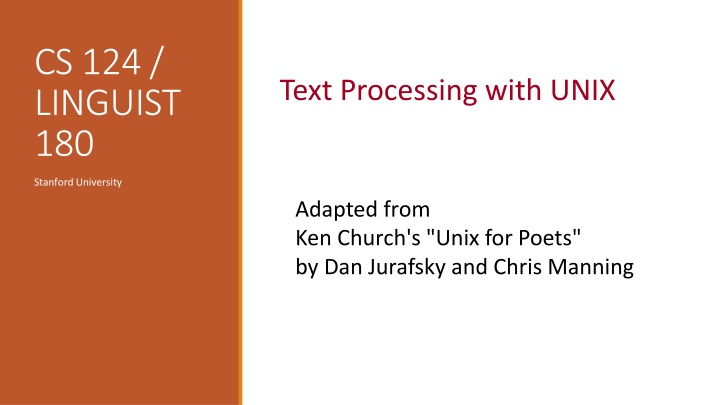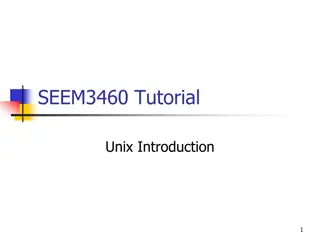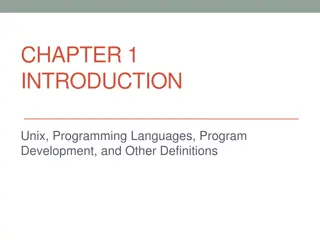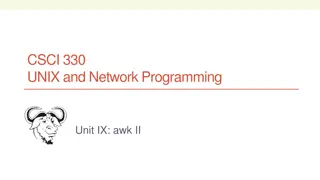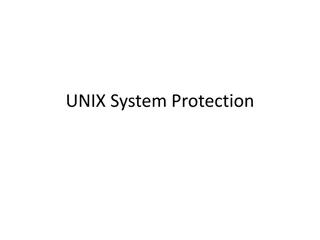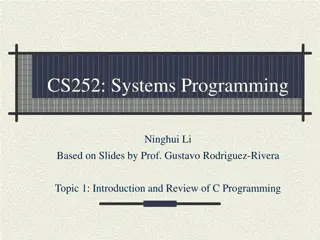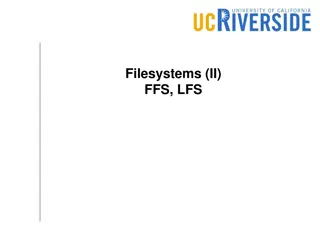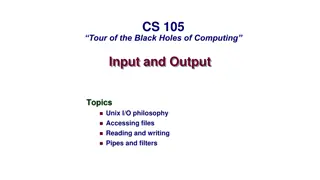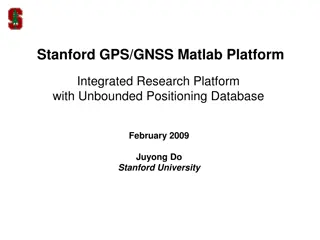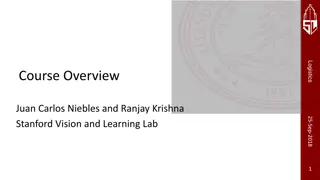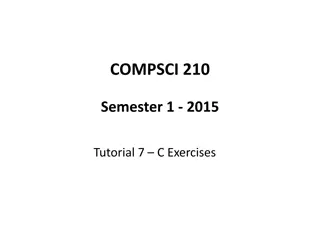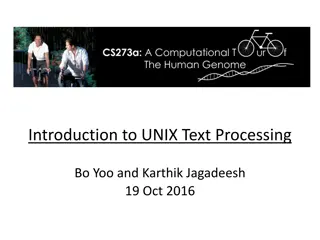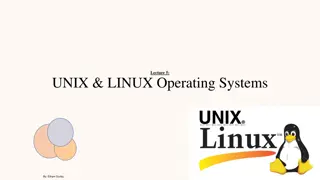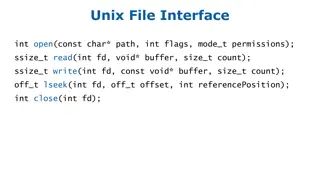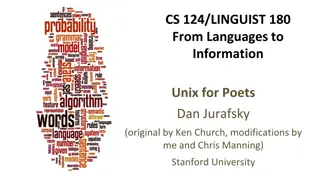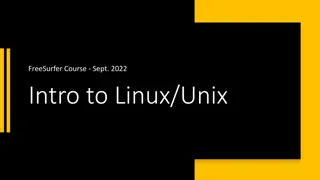Text Processing with UNIX at Stanford University
This course at Stanford University delves into the realm of text processing with UNIX, exploring the vast world of words found in web content, emails, and social media. Discover the power of UNIX tools like "tr," "sort," "uniq," "grep," and "sed" to manipulate and analyze text data effectively. Learn techniques for counting words, identifying patterns, and ensuring data ethics. Dive into practical exercises and tools to enhance your text processing skills. Pre-requisites include basic knowledge of using UNIX command line tools. Get ready to enhance your text processing capabilities with this hands-on course!
Download Presentation

Please find below an Image/Link to download the presentation.
The content on the website is provided AS IS for your information and personal use only. It may not be sold, licensed, or shared on other websites without obtaining consent from the author.If you encounter any issues during the download, it is possible that the publisher has removed the file from their server.
You are allowed to download the files provided on this website for personal or commercial use, subject to the condition that they are used lawfully. All files are the property of their respective owners.
The content on the website is provided AS IS for your information and personal use only. It may not be sold, licensed, or shared on other websites without obtaining consent from the author.
E N D
Presentation Transcript
CS 124 / LINGUIST 180 Text Processing with UNIX Stanford University Adapted from Ken Church's "Unix for Poets" by Dan Jurafsky and Chris Manning
Text processing with UNIX Billions of words are text are everywhere The web, email, social media What can we do with it all? The UNIX intuition: Modularity and simplicity! Simple command-line tools combined together Often faster even than writing a quick python tool DIY is very satisfying 2
7 exercises well be doing today 1. Count words in a text with "tr", "sort", and "uniq" 2. Counting more complex text patterns with "tr" 3. Using "sort" in more powerful ways for counting 4. Using "grep" to find patterns 5. Data ethics: Where did this data come from? 6. Simple tricks to compute n-gram statistics 7. Using "sed" to modify text 3
Tools sort uniq c (count duplicates) tr (translate characters) grep: search for a pattern (regular expression) cat (send file(s) in stream) head tail rev (reverse lines) sed (edit string -- replacement) 4
Prereqs: Mac: Open the Terminal app Windows: Make sure you have Ubuntu (PA0) I 5
Prerequisites: get the text file we are using rice: ssh into a farmshare and then do (don't forget the final ".") cp /afs/ir/class/cs124/WWW/nyt_200811.txt . Or download to your own laptop this file: http://cs124.stanford.edu/nyt_200811.txt Or: scp rice:/afs/ir/class/cs124/WWW/nyt_200811.txt . 6
Prerequisites The UNIX man command e.g., man tr man shows you the command options it's not particularly friendly 7
Prerequisites How to chain shell commands and deal with input/output Input/output redirection: > output to a file < input from a file | pipe CTRL-C The less command (quit by typing "q")
Exercise 1: Count words in a text Input: text file (nyt_200811.txt) Output: list of words in the file with freq counts Algorithm 1. Tokenize (tr) 2. Sort (sort) 3. Count duplicates (uniq c) Go read the man pages and figure out how to pipe these together 9
Solution to Exercise 1 tr -sc 'A-Za-z' '\n' < nyt_200811.txt | sort | uniq -c 633 A 1 AA 1 AARP 1 ABBY 41 ABC 1 ABCNews (Do you get a different sort order? In some versions of UNIX, sort doesn't use ASCII order (uppercase before lowercase).) 10
Some of the output tr -sc 'A-Za-z' '\n' < nyt_200811.txt | sort | uniq -c | head n 5 633 A 1 AA 1 AARP 1 ABBY 41 ABC tr -sc 'A-Za-z' '\n' < nyt_200811.txt | sort | uniq -c | head head gives you the first 10 lines tail does the same with the end of the input (You can omit the -n but it s discouraged.)
Ex 2: Extended Counting Exercises 1. Merge upper and lower case by downcasing everything Hint: Put in a second tr command 2. How common are different sequences of vowels (e.g., the sequences "ieu" or just "e" in "lieutenant")? Hint: Put in a second tr command 12
Solutions Merge upper and lower case by downcasing everything tr -sc 'A-Za-z' '\n' < nyt_200811.txt | tr 'A- Z' 'a-z' | sort | uniq -c or tr -sc 'A-Za-z' '\n' < nyt_200811.txt | tr '[:upper:]' '[:lower:]' | sort | uniq -c 1. tokenize by replacing the complement of letters with newlines 2. replace all uppercase with lowercase 3. sort alphabetically 4. merge duplicates and show counts
Solutions How common are different sequences of vowels (e.g., ieu) tr 'A-Z' 'a-z' < nyt_200811.txt | tr -sc 'aeiou' '\n' | sort | uniq -c 14
Sorting and reversing lines of text sort sort f Ignore case sort n Numeric order sort r Reverse sort sort nr Reverse numeric sort echo "Hello" | rev 15
Ex 3: Counting and sorting exercises Find the 50 most common words in the NYT Hint: Use sort a second time, then head Find the words in the NYT that end in "zz" Hint: Look at the end of a list of reversed words tr 'A-Z' 'a-z' < filename | tr sc 'a-z' '\n' | rev | sort | rev | uniq c 16
Ex 3 Counting and sorting solutions Find the 50 most common words in the NYT tr -sc 'A-Za-z' '\n' < nyt_200811.txt | sort | uniq -c | sort -nr | head -n 50 Find the words in the NYT that end in "zz" tr -sc 'A-Za-z' '\n' < nyt_200811.txt | tr 'A-Z' 'a-z' | rev | sort | uniq -c | rev | tail -n 10 17
grep Grep finds patterns specified as regular expressions grep rebuilt nyt_200811.txt Conn and Johnson, has been rebuilt, among the first of the 222 move into their rebuilt home, sleeping under the same roof for the the part of town that was wiped away and is being rebuilt. That is to laser trace what was there and rebuilt it with accuracy," she home - is expected to be rebuilt by spring. Braasch promises that 18
grep Grep finds patterns specified as regular expressions globally search for regular expression and print (A much easier way to find words ending in a pattern than the rev method we used before) Finding words ending in ing: grep 'ing$' nyt.words |sort | uniq c 19
grep grep is a filter you keep only some lines of the input grep gh keep lines containing gh grep ' con' keep lines beginning with con grep 'ing$' keep lines ending with ing grep v gh keep lines NOT containing gh
grep versus egrep (grep E) egrep or grep -E [extended syntax] In egrep, +, ?, |, (, and ) are automatically metacharacters In grep, you have to backslash them To find words ALL IN UPPERCASE: egrep '^[A-Z]+$' nyt.words |sort|uniq -c == grep '^[A-Z]\+$' nyt.words |sort|uniq -c (confusingly on some systems grep acts like egrep)
Ex 4: Exercises on grep & wc How many all uppercase words are there in this NYT file? How many 4-letter words? How many different words are there with no vowels What subtypes do they belong to? Type/instance distinction: different words (types) vs. instances (sometimes called "type/token" distinction but we now save "token" for BPE tokens) 22
Ex 4 Solutions on grep & wc How many all uppercase words are there in this NYT file? grep -E '^[A-Z]+$' nyt.words | wc How many 4-letter words? grep -E '^[a-zA-Z]{4}$' nyt.words | wc How many different words are there with no vowels grep -v '[AEIOUaeiou]' nyt.words | sort | uniq | wc Type/instance distinction: different words (types) vs. instances
Lesson Piping commands together can be simple yet powerful in Unix It gives flexibility. Traditional Unix philosophy: small tools that can be composed 24
Ex 5: Data Ethics The text for today s lab comes from the New York Times Annotated Corpus, released by the Linguistic Data Consortium. Understanding a dataset's origins gives us insight into its scope and limitations, which can affect the conclusions we draw from it. Take a few minutes with your group to explore the origins of this text. What types of texts, from what time period, genre, and language, are included in this dataset? What types are not? Then, answer questions on the following slide
Data Ethics Questions 1. Imagine you are a researcher creating an educational platform as part of a high-school history course, and you trained your model solely on text from this corpus. Though the NYT is a respected publication, its content reflects its very particular context. What biases could arise from relying solely on this corpus for training your model? (For example, whose perspectives are predominantly included, and whose might be underrepresented or excluded?) 2. With your group, brainstorm ways to reduce the biases identified in part (1) when building this tool. How would you evaluate the effectiveness of these methods in reducing biases?
Bigrams = word pairs and their counts Algorithm: 1. Tokenize by word 2. Create two almost-duplicate files of words, off by one line, using tail 3. paste them together so as to get wordiand wordi +1on the same line 4. Count 27
Bigrams tr -sc 'A-Za-z' '\n' < nyt_200811.txt > nyt.words tail -n +2 nyt.words > nyt.nextwords paste nyt.words nyt.nextwords > nyt.bigrams head n 5 nyt.bigrams KBR said said Friday Friday the the global global economic 28
Ex 6: Bigrams Find the 10 most common bigrams (Just for you to notice:) What part-of-speech pattern are most of them? 29
Ex 6 Solutions Find the 10 most common bigrams tr 'A-Z' 'a-z' < nyt.bigrams | sort | uniq -c | sort -nr | head -n 10 30
sed sed is used to change strings in a file (larger changes than tr ) sed is line-based. You specify a regex substitution to make on each line (Optional: you can specify a subset of lines, by regex or line numbers) For example, to change all cases of George to Jane : sed 's/George/Jane/' nyt_200811.txt | less 31
Ex 7: sed exercises 1. Count frequency of word initial consonant sequences Take tokenized words Delete the first vowel through the end of the word Sort and count 2. Optional: Count word final consonant sequences 32
Ex 7 sed exercises solutions Count frequency of word initial consonant sequences tr "[:upper:]" "[:lower:]" < nyt.words | sed 's/[aeiou].*$//' | sort | uniq -c Optional: Count word final consonant sequences tr "[:upper:]" "[:lower:]" < nyt.words | sed 's/^.*[aeiou]//' | sort | uniq -c | sort -rn | less 33
Extra Credit Secret Message Now, let s get some more practice with Unix! The answers to the extra credit exercises will reveal a secret message. We will be working with the following text file for these exercises: https://web.stanford.edu/class/cs124/lec/secret_ec.txt To receive credit, enter the secret message here: https://docs.google.com/forms/d/e/1FAIpQLSdrr1p31AGkgZJSu 7-sLtxbobJIsPdkq5KXe0n7jKZosGWNAw/viewform 34
Extra Credit Exercise 1 Find the 2 most common words in secret_ec.txt containing the letter e. Your answer will correspond to the first two words of the secret message. 35
Extra Credit Exercise 2 Find the 2 most common bigrams in secret_ec.txt where the second word in the bigram ends with a consonant. Your answer will correspond to the next four words of the secret message. 36
Extra Credit Exercise 3 Find all 5-letter-long words that only appear once in secret_ec.txt. Concatenate (by hand) your result. This will be the final word of the secret message. 37
